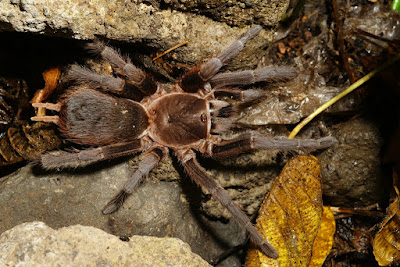FUNDECI/GAIA maintains a reforestation project over several years in
Laguna de Apoyo Nature Reserve. Given the extremely fragile nature of the volcanic soils in this reserve, we have chosen to dedicate part of our budget and time to protect and increase the forest cover. The soil is mostly very light volcanic ash between volcanic rocks, and it erodes extremely easily with rains when forest cover is absent. Here, we present some information about one of our reforestation areas, in which we have been planting and caring for trees five years, with the essential help of many volunteers. The reforestation plot is next to a working agroforestry plot, both owned by the same, local (Nicaraguan) person.
 |
| A native olive species (Simarouba amara) is planted in the forest next to a small banana plantation. Photo by Giselle Hernandez. |
We plant and husband trees in deforested areas to facilitate their return to natural forest inside the
Laguna de Apoyo Nature Reserve. One of the species we like to plant in natural forest restoration
Simarouba amara, a native olive tree. We only plant native species and we use local genetic material. Olive requires ample light to grow, but its growth is relatively rapid and it produces a wide canopy with evergreen leaves shading the ground from the impact of rain. The fruit is ripe in March and April, and is sought by birds, monkeys and many other mammals. By providing soil protection and food for native species, it helps recover the natural forest rapidly. The olive tree helps forests maintain populations of endangered wildlife such as howler monkeys.
 |
| After four years, this tree has reached six meters height. Photo by Giselle Hernandez. |
Grasses usually cover the exposed ground in deforested areas, but they are counterproductive for reforestation. Spaces such as the one above do not exist in unaltered natural forest in the tropical dry forest ecosystem. The annual plants, especially grasses, grow much faster than tree seedlings, so they can choke out natural tree regeneration from nutrients and light. In the dry season, the annual vegetation dries and may burn, killing all but the largest and most resistant of trees. Fires make the greatest threat to reforestation in natural areas.
Because our objective is restoring a natural forest and not reforesting with forestry production species, and because we are planting trees in highly eroded and fragile habitats, We expect to obtain far lower survival rates and tree growth. No germination and silvicultural advice exists for some of our species.
 |
| Pitahaya (Hylocereus costaricensis), also known in English as Dragon Fruit, is an epiphytic cactus found in many trees in Laguna de Apoyo Nature Reserve. Photo by Giselle Hernandez. |
The steep slopes which dominate the crater interior accelerate the erosion process when forest cover is removed. Land with more than 15% slopes is unfit for any kind of annual cultivation, yet much of the steeply sloped land in the Laguna de Apoyo Nature Reserve still has annual crops on it or is just left without forest cover. We make agreements with owners who want to have their land reforested, and we provide the service free of charge, thanks to volunteers!
 |
| Melero (Thouinidium decandrum) planted on the edge of this agroforestry plot in Laguna de Apoyo Nature Reserve. Ripening bananas can be seen in the background. Photo by Giselle Hernandez. |
One of the objectives of natural forest rehabilitation is to maximize the diversity of species in each reforestation plot. Most reforestation projects concentrate on one or only a few species of trees in a plot. In contrast, we plant trees of several species, including many that do not grow well in a semi-artificial setting such as a tree nursery. We have to accept very low germination yields and losses of young trees in many species because we don't want only the three or four species that are easy to grow. To sustain wildlife, a patch of forest needs many species of trees.
 |
| Restoring a natural forest requires a number of elements which are not expected of most reforestation projects. Photo by Giselle Hernandez. |
 |
| Our reforestation trees already reach two meters height, providing a complex vegetation structure and effective ground cover after only a few years. Photo by Giselle Hernandez. |
We have learned a lot about natural forest rehabilitation in the past several years, but we have more to learn and more to do. Reforesting in our crater is essential to provide habitat for the wild terrestrial animals, and to protect Lake Apoyo from erosion. Our project differs from other reforestation projects in Nicaragua, because we try to recreate wild, natural habitat, and we care for our trees years after they are planted in the forest plots.























